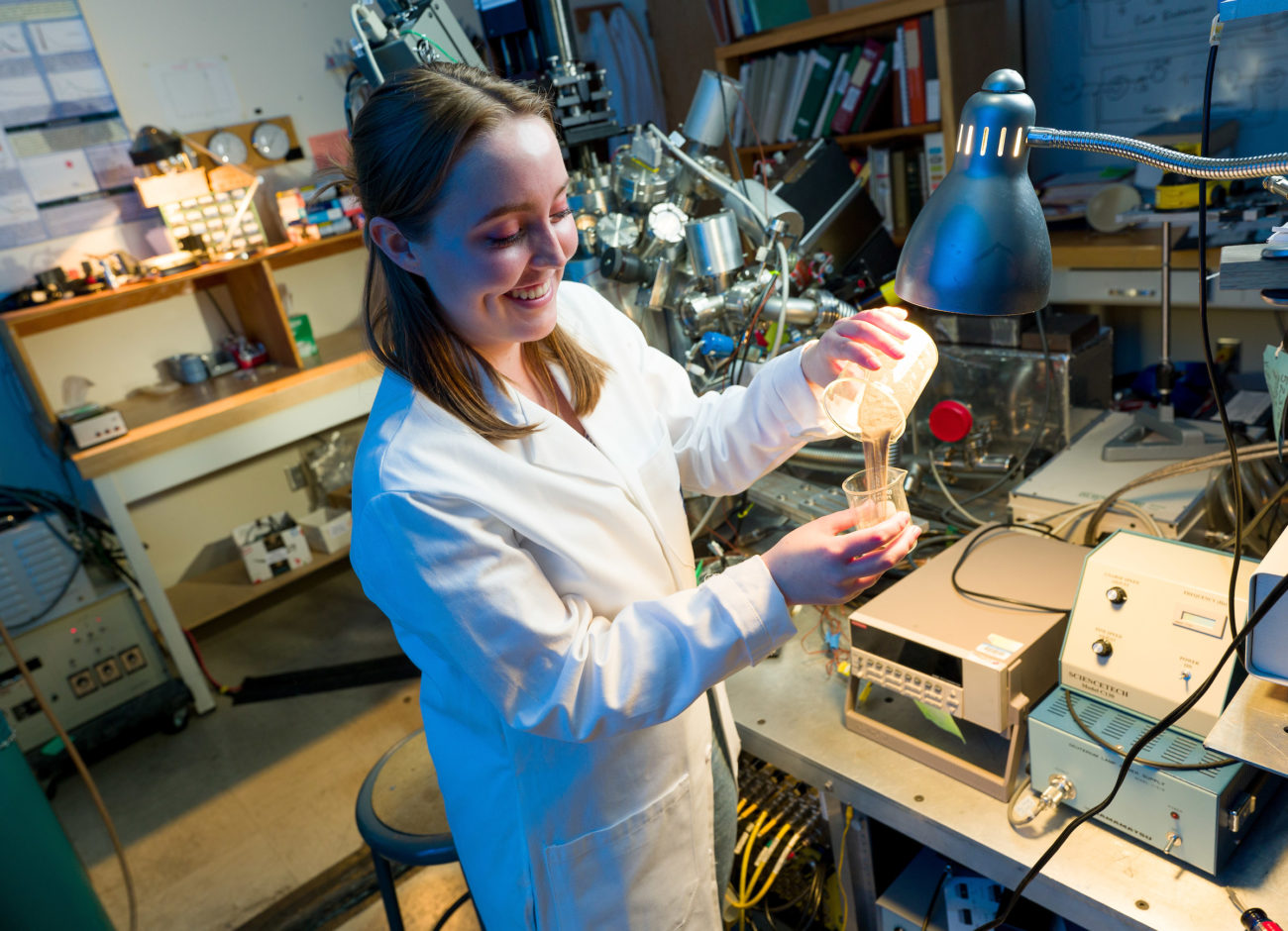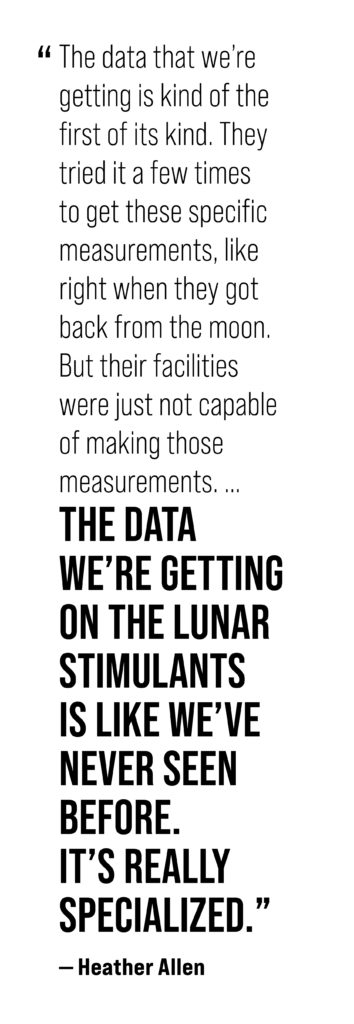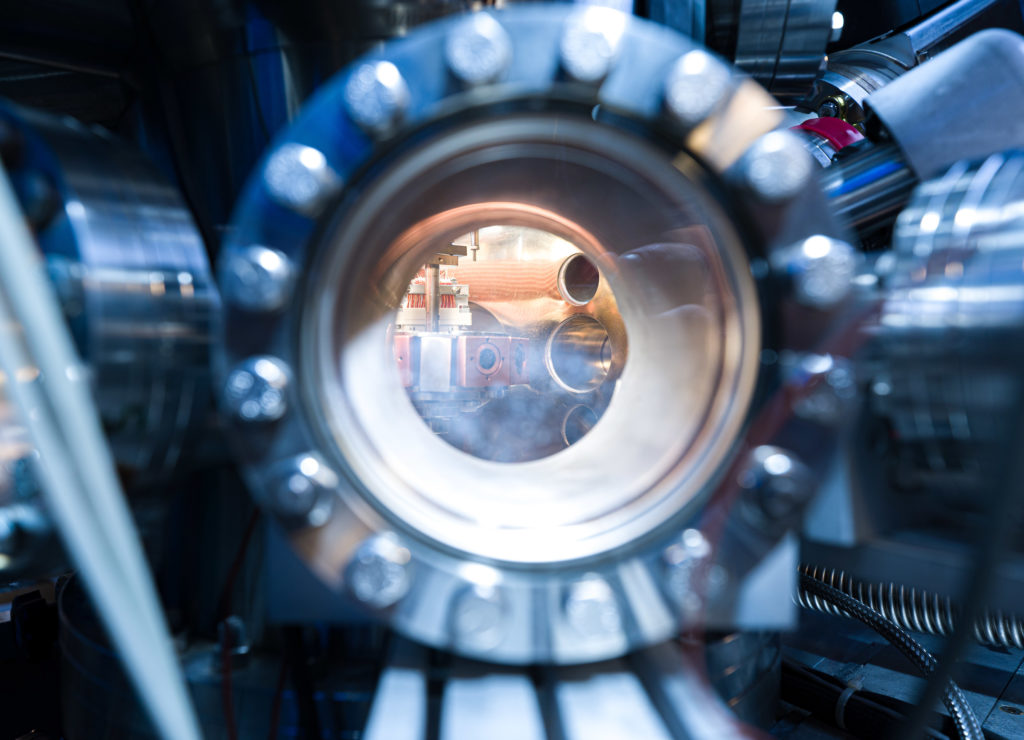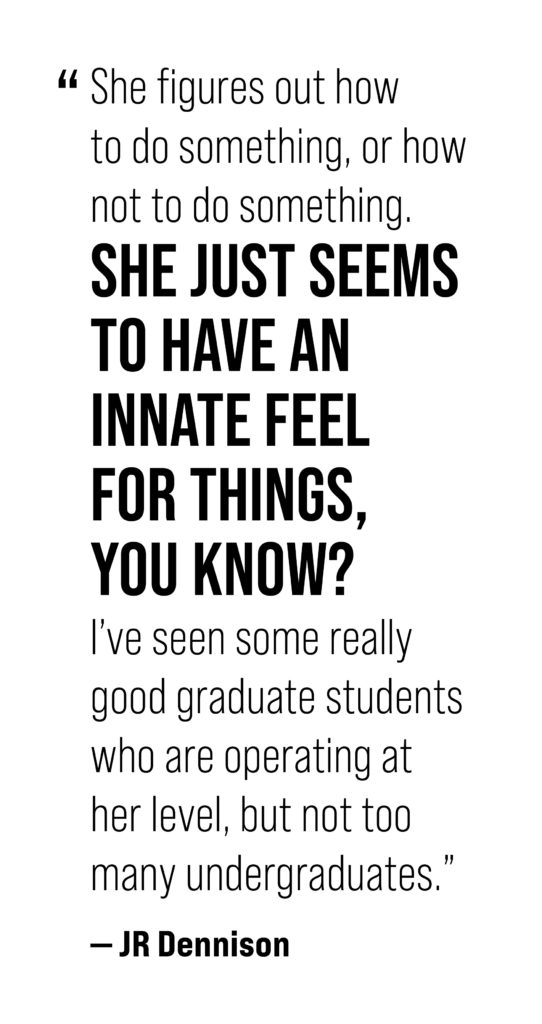Recent USU Graduate Uses Vacuum Chamber to Study Effects of ‘Moon Dust’

Heather Allen, now off to Penn State to pursue a Ph.D., honed her skills as a member of professor JR Dennison’s Material Physics Group
By Jeff Hunter ’96
It certainly wasn’t a life-threatening situation like what the Apollo 13 crew dealt with during an ill-fated space mission in 1970. But like the astronaut trio of Jim Lovell, John Swigert and Fred Haise, Heather Allen also has a strong curiosity when it comes to the surface of the moon.
And when things went wrong during a research project involving lunar dust last summer, the recent Utah State University graduate had to get creative. In her eyes, failure was not an option.
“It was definitely out of desperation,” Allen admits when asked what led her to inexplicably taking apart and repairing a vacuum chamber in a basement laboratory in the Science Engineering Research (SER) building with zero experience and practically no assistance.
“Otherwise, we weren’t going to get anything done.”

A member of JR Dennison’s Material Physics Group, Allen had shadowed a graduate student more familiar with the chamber for just over a week before he left for a summer internship. The extremely complex device was being used to measure the effects of sharp, charged dust particles — similar to those found on the moon — that can potentially damage spacecraft, tear through spacesuits and even penetrate the lungs of astronauts.
“I was just trying to figure out how everything worked, and the day he left, it stopped working,” Allen explains. “It was literally the first day I was on my own, and it wasn’t working.”
But unlike the Apollo 13 crew, Allen didn’t have the support of dozens of scientists to help her diagnose the problem and come up with a solution. Dennison had just left for Europe, and everyone else familiar with the chamber was gone for the summer. That left Allen “frantically sending emails and digging through old documents” trying to figure out how to repair a device that had been built on the USU campus and didn’t exactly come with an owner’s manual.
Eventually, the Pleasant Grove native was able to determine that “one tiny piece” was broken inside the machine, requiring her to create a new version — something she had no experience doing — take apart the vacuum chamber, replace the piece and then put the chamber back together.
“Even then, it almost didn’t work,” Allen says with a laugh. “But that was months’ worth of effort just trying to figure out what was wrong because there was no one here to help me.”

Dennison, who has taught physics at USU since 1988, is still stunned by Allen’s determination and ingenuity.
“By the end of the summer, Heather had it working and was taking some of the best data we’ve ever seen on that instrument,” Dennison proclaims. “I’ve said this a bunch times, but I’ll say it again: Wow! But more and more, that’s kind of what we’ve come to expect from Heather. She figures out how to do something, or how not to do something. She just seems to have an innate feel for things, you know? I’ve seen some really good graduate students who are operating at her level, but not too many undergraduates.”
Allen will now take her skills to the graduate level. The Robins Award winner for the Peak Prize: Undergraduate Researcher of the Year is headed to Penn State University this fall on a fellowship after graduating from USU in May with a bachelor’s degree in physics and a double minor in math and computer science. The O. Harry Otteson Award winner as the USU physics student with the highest grade in introductory physics plans to pursue a Ph.D. in physics at Penn State with an emphasis in material sciences.
“Heather’s creative and has some innate skills.,” Dennison says of his protégé. “A lot of people, when they look at a problem, never know where to invest their time making mistakes to try and figure it out. But she seems to be exceptional at that, and she’s also very, very persistent, and diligent.
“Heather will go on to do great things, I have no doubt,” Dennison adds.

After originally planning to pursue a degree in mechanical engineering with an aerospace emphasis, Allen switched her status to “undeclared” as a freshman when that started feeling like too daunting of a path. It wasn’t until after talking to a counselor in the Exploratory Advising office and hearing “Physics sounds like a good match,” that she officially declared her pursuit of a physics major despite admitting, “I really didn’t like physics in high school.”
Allen joined the Material Physics Group her junior year, and under Dennison’s tutelage, she began working on the group’s lunar dust research project along with graduate students Matthew Robertson and Tom Keaton. NASA’s plan to return to the moon via the Artemis missions has renewed interest in the potentially disastrous effects of lunar dust on spacesuits and space vehicles, so the agency is very interested in knowing how to avoid life-threatening and costly mechanical damage on future missions.
“Lunar dust is a very, very fine powder,” Dennison explains. “The rocks and soil on the moon’s surface have been subject to meteor bombardment for 3 billion years or so, and what’s left is like flour. But it’s highly insulating. And because there’s no atmosphere to slow down the incoming charge particles from the sun and other places, and there’s no atmosphere like here to discharge things, things charge up and stay charged forever. And they get into everything.”
On Earth, dust is smoothed out over time from erosion by wind and water, but on the moon the dust is sharp and spiky and electrostatically charged due to its constant exposure to radiation from the sun. Apollo 17 mission commander Gene Cernan, the last man to walk on the moon, said of lunar dust after returning the moon in 1972: “I think dust is probably one of our greatest inhibitors to a nominal operation on the moon. I think that we can overcome other physiological or physical or mechanical problems except dust.”
While Allen would love the opportunity to conduct research with actual dust like Cernan was exposed to on the moon, it is extremely rare and difficult to acquire. Therefore, the experiments in the SER lab have been conducted with aluminum oxide and silicone dioxide, the primary components of lunar dust.
During her final couple of years at Utah State, it’s probably fair to say that Allen — who fashioned an electron gun for use in the chamber — was much more concerned about dust than the average college student. She believes that the efforts of her and her colleagues in analyzing the charging properties of lunar dust simulants through electron yield measurement has led to “new data that hasn’t really been done before.”
“The data that we’re getting is kind of the first of its kind,” Allen notes. “They tried it a few times to get these specific measurements, like right when they got back from the moon. But their facilities were just not capable of making those measurements. … The data we’re getting on the lunar stimulants is like we’ve never seen before. It’s really specialized.”
“One of the specific goals that we have eventually is to update the values in NASA’s modeling systems for what they use in answering questions like, ‘Will this astronaut suit survive the moon?’” Allen continues. “They’re currently using dated, and, frankly, inaccurate measurements on the charging properties of dust. And so, we hope to update those values, make them more accurate and influence decisions that way.”





